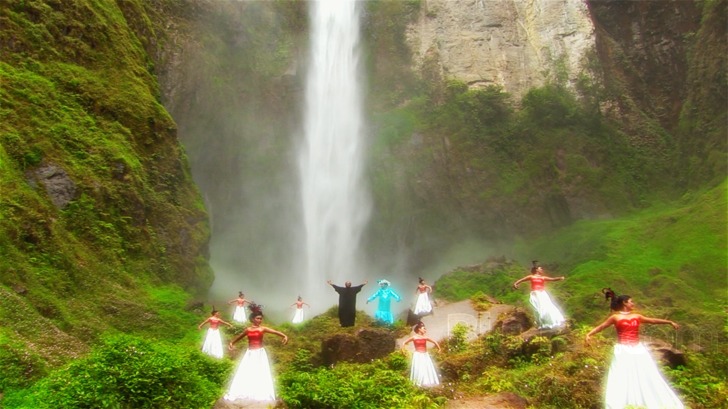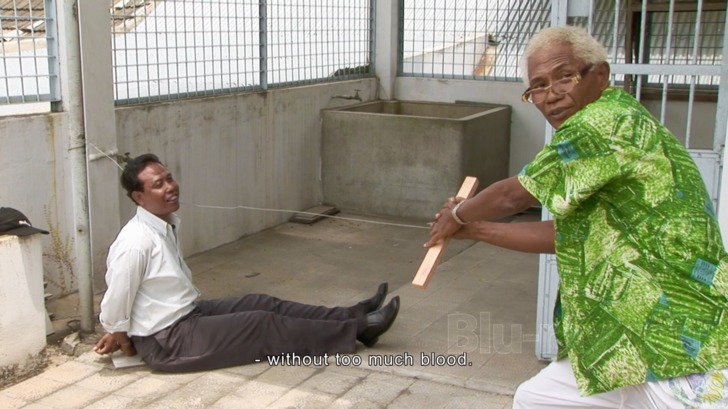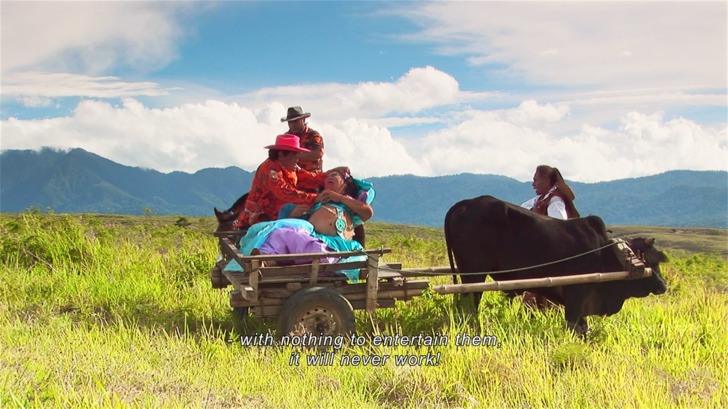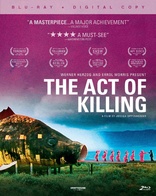The Act of Killing Blu-ray Movie
HomeThe Act of Killing Blu-ray Movie 
Blu-ray + Digital CopyDrafthouse Films | 2012 | 1 Movie, 2 Cuts | 167 min | Not rated | Jan 07, 2014
Movie rating
8 | / 10 |
Blu-ray rating
| Users | 4.5 | |
| Reviewer | 4.5 | |
| Overall | 4.5 |
Overview
The Act of Killing (2012)
Documentary about members of the Indonesian death squads who tortured and killed over 1 million people throughout 1965 and 1966 and remain unpunished and unrepentant, because the government they served remains in power. The documentary crew invites several former death squad members to recreate their actions for the camera, and the results are surreal, provocative and disturbing.
Starring: Anwar Congo, Herman Koto, Ibrahim Sinik, Adi ZulkadryDirector: Joshua Oppenheimer (II), Christine Cynn, Anonymous (LXI)
| Foreign | Uncertain |
| Documentary | Uncertain |
| History | Uncertain |
| Crime | Uncertain |
Specifications
Video
Video codec: MPEG-4 AVC
Video resolution: 1080p
Aspect ratio: 1.78:1
Original aspect ratio: 1.85:1
Audio
Indonesian: DTS-HD Master Audio 5.1
Subtitles
English
Discs
50GB Blu-ray Disc
Two-disc set (2 BDs)
Digital copy (as download)
Packaging
Slipcover in original pressing
Playback
Region A (locked)
Review
Rating summary
| Movie | 5.0 | |
| Video | 4.5 | |
| Audio | 4.0 | |
| Extras | 4.5 | |
| Overall | 4.5 |
The Act of Killing Blu-ray Movie Review
The Film's the Thing
Reviewed by Michael Reuben January 5, 2014Joshua Oppenheimer's The Act of Killing takes the documentary into territory that used to be the exclusive province of fiction: a place where fantasy and reality collide, motivations are uncertain, actions are rife with subtext and characters keep revealing hidden layers. The key difference is that many of the events being depicted on the screen really happened, and real people suffered the consequences. The result, says Oscar-winning documentarian Errol Morris (The Fog of War), one of the film's executive producers, "is truly unlike any other documentary film." Esteemed German filmmaker Werner Herzog, also an executive producer, echoes the sentiment: "I immediately knew I had never seen anything like [this film]. I'd never seen anything as powerful, as frightening and as surreal . . . ." An American now living in Denmark, Oppenheimer spent five years in Indonesia filming The Act of Killing (after three years investigating the subject). One of the film's side effects is to portray a society entirely based on graft and corruption, which is no small affair when you're dealing with the fourth most populous country on earth (after China, India and the U.S.). Political office is openly bought and sold, businesses are extorted, and the well-connected can call on a huge paramilitary organization, the Pancasila, to intimidate whatever they want from whomever has it. Oppenheimer likens this world to Nazi Germany if the Nazis were still in power today and retired S.S. officers were lionized for their role in the Holocaust, but an equally apt analogy might be American life if all bans on organized crime were repealed and the likes of Tony Soprano were hired as government contractors to eliminate dissidents and maintain "domestic tranquility". Oppenheimer's portrait of contemporary Indonesian society emerges through a focused inquiry into one of its founding events, the systematic extermination of an estimated one million government opponents (indiscriminately labeled "communists") in 1965-1966 after a military coup. To accomplish these mass killings, the government turned to paramilitary units, later formally organized as the Pancasila, and street thugs who called themselves "gangsters", which, in Indonesian, is derived from the Dutch words for "free man". Forty years later, many of these killers walk openly among the descendants of their victims and are hailed as heroes. After interviewing some of these individuals, Oppenheimer encountered Anwar Congo, a character so extraordinary that, if a writer imagined him, everyone would say he couldn't exist. The Act of Killing might just as accurately be entitled Being Anwar Congo, because Oppenheimer's film undertakes the challenge of leading the viewer into the mind of someone who actually killed an estimated 1,000 people, is quite happy to tell you all about it and may or may not have regrets, depending on whether the camera is running. Drafthouse Films is releasing The Act of Killing in two versions on Blu-ray. The 122-minute theatrical cut played at the Toronto International Film Festival in September 2012 and premiered in U.S. theaters in July 2013. The 167-minute director's cut is the only version to be shown in Indonesia, where the film was released publicly but without formal government approval and has resurrected topics that the general populace were previously afraid to discuss openly.

If The Act of Killing doesn't hook you with its surreal teaser, then the film is not for you. The first screenshot provides a hint of this opening, which is Anwar Congo's vision for a Hollywood-style musical number in the movie he wants to make about his exploits. The full version isn't unveiled until near the end of the film. It's worth the wait. After the teaser, Oppenheimer provides a short historical introduction that concludes as follows:
When we met the killers, they proudly told us stories about what they did. To understand why, we asked them to create scenes about the killings in whatever ways they wished. This film follows that process, and documents its consequences.Anwar Congo loves the movies. Before he became a hired killer, he was a petty crook who scalped tickets at the cinema in Medan, the capital city of North Sumatra. When he was recruited as an assassin—the details are vague, but the head man was apparently a local newspaper publisher, Ibrahim Sinik, who is also interviewed—Anwar adapted killing techniques he'd seen in Hollywood films. His preferred method, strangulation by wire, which he proudly demonstrates, came from gangster movies. Over a period of several years, Anwar and his associates develop, cast and shoot what they think will be a movie re-creating and reenacting his exploits, with Oppenheimer's crew dutifully shooting whatever they are asked to record. They stage the musical sequence glimpsed at the opening; a surreal Western-style assault; an interrogation scene in American gangster regalia lit in the style of film noir; various fantasy and dream sequences; and a scarily realistic massacre at a replica of a country village, using numerous hired extras and members of the Pancasila brigade. The last is attended by a government minister, who is initially concerned about how this may look to outsiders, but on reflection decides that it's a good thing to show the world just how fiercely Indonesia's "free men" will defend her. Throughout this process, Oppenheimer continues to interview Anwar, who speaks more and more openly about his actions, his thoughts, even his nightmares. He also records Anwar watching segments of his "movie" and offering observations and comments. Anwar is a beguiling performer, and he is clearly addicted to his own celebrity. Oppenheimer and his editors construct their sequences skillfully so that Anwar's practiced charm at winning over people always sets up the viewer for a sucker punch with some ghastly revelation or shocking edit that reminds you of who he is and what he's done. (Note: Anwar Congo's hair was gray when Oppenheimer met him; he died it black for his appearances in the "movie"; and it had grown out by the end of Oppenheimer's shoot. Because The Act of Killing is constructed thematically, not chronologically, Anwar's hair color switches back and forth between shots. If nothing else, it's one more reminder that Oppenheimer's film is an artistic construct, not a transcript. Werner Herzog is eloquent in his interview on the difference and why it matters.) What passes for comic relief in The Act of Killing is frequently provided by Anwar's circle of friends and contacts, through whom we get a wider view of the society he helped create and that worships him as a hero. His closest associate, Herman Koto, who co-stars in their movie, is asked to run for Parliament but is given no money to bribe voters; visions of wealth dance before him as he totals for Oppenheimer the payoffs that a member of Parliament can expect. A group of Anwar's Pancasila friends storm through a local Chinese market extorting protection money to finance a reception for a "special" friend, who turns out to be Indonesia's vice president, Jusuf Kalla; he congratulates the enthusiastic Pancasila crowd for their role in keeping Indonesia strong. (In his commentary, Oppenheimer reveals that the film crew reimbursed all the Chinese merchants.) A top Pancasila official, Haji Anif, proudly shows the valuable land he strong-armed from its owners with the threat of paramilitary force; he's transformed it into a bird sanctuary.

- Excerpts from an anti-communist propaganda film created by the regime that employed Anwar; its crude effects and exaggerated acting clearly influenced Anwar's re-enactments.
- Anwar's demonstration of an alternative, "fun" method of killing, using a table.
- More extensive rehearsals and shooting of the cowboy sequence, including a scene with elephants as "background".
- A graphic re-creation of an interrogation, in which Anwar murders Herman's "child" (in fact, a teddy bear) as a form of torture.
- A longer and more comprehensible version of the scene in which Anwar, playing the victim in a re-creation, appears to have some sort of breakdown.
- A conversation between Anwar and Adi that concludes with their agreeing that, in the old days, they probably would have killed Oppenheimer.
The Act of Killing Blu-ray Movie, Video Quality 

Oppenheimer and his largely Indonesian crew (all identified as "Anonymous" in the credits) shot The Act of Killing with small digital cameras, probably of several varieties over the multi-year production period. Footage shot for the various re-creations obviously benefitted from professional lighting, but interviews vary in quality depending on conditions and time of day. The digital colorist has done a fine job of massaging the disparate sources into a coherent whole. For the most part, the image on Drafthouse/Cinedigm's two 1080p, AVC-encoded Blu-rays (one each for the theatrical and director's cuts) is quite satisfying, with impressive detail, solid blacks and a varied and vibrant color palette. Some shots (e.g., an early interview with Anwar and Herman) have the detail "blown out" by excessive brightness, but this appears to be source-based rather than a transfer error, because contrast levels are generally well-calibrated. Video noise is frequently noticeable, but again this appears to be source-based, probably reflecting the limitations of the equipment rather than a fault in the transfer. Some studios use digital origination as an excuse to attempt high levels of compression, but Drafthouse has mastered The Act of Killing at a generous average bitrate of 29.96 Mbps (29.99 for the director's cut). In general, the Blu-ray appears to be an accurate reproduction of the film as shot and edited, with concerns about video noise being the only reason that the video score isn't a perfect 5.
The Act of Killing Blu-ray Movie, Audio Quality 

The Act of Killing arrives with a lossless DTS-HD MA 5.1 soundtrack in Indonesian with non-switchable English subtitles (and no other subtitle options). The mix is not a surround extravaganza, but it is extremely sophisticated. Just as Oppenheimer chooses his edits carefully, he is deliberate in choosing when to include ambiant noises in the mix and when to remove them, leaving only one or two elements. A striking example occurs in the village massacre re-enactment, as a scene that, in real life would be a screaming cacophony of horror gradually goes quiet until only the sound of a person breathing (presumably Anwar) can be heard. Then someone calls "Cut!", and normal sound resumes. This sort of subjective sound editing occurs throughout The Act of Killing, although it is most obvious at edit points. The film's soundtrack is largely front-oriented, as is the case with most documentaries. The surrounds provide occasional support, especially for musical selections like the strikingly inappropriate (and therefore perfectly suited) "Theme for The Act of Killing" composed by Karsten Fundal, as well as Anwar's chosen selection for his "movie's" musical interlude, which I'll not spoil for those who don't already know it.
The Act of Killing Blu-ray Movie, Special Features and Extras 

Except for the commentary, all of the extras accompany the theatrical cut.
- Commentary with Director Joshua Oppenheimer and Executive Producer Werner Herzog (director's cut): A combination discussion, interview and critical appreciation, this is a valuable commentary on multiple levels. It contains substantial information about the shooting of the film, including crucial detail about when certain scenes were filmed in the extended shooting schedule and a few revelations about events off-camera. Herzog often prompts Oppenheimer for more information about his technique, and just as often stops to comment on specific shots and edits that he admires, even ones that, as Herzog laughingly acknowledges, would probably get Oppenheimer thrown out of film school. At one point, he even draws a comparison between a scene in The Act of Killing and one from his own Aguirre: The Wrath of God—high praise indeed.
- Interview with Joshua Oppenheimer on Democracy Now (1080i; 1.78:1; 45:32): Democracy Now is an independent news program airing on Pacifica, PBS, NPR and local access stations, among others. This installment was shown on July 19, 2013, the date that The Act of Killing opened in New York City. In the first segment, Oppenheimer provides additional historical context for the 1965 murders re-created in the film. In the second, he talks about his early interviews with killers and his attempts to interview victims' families, which the Indonesian government stopped; Anwar Congo was the 41st killer he interviewed. In the third segment, Oppenheimer provides a theory of why Anwar re-enacted his crimes as he did, and also describes the reaction to the film in Indonesia.
- VICE Presents Werner Herzog and Errol Morris on THE ACT OF KILLING (1080p; 1.78:1; 12:30): Interviewed separately, Herzog and Morris discuss what makes The Act of Killing unique. (Vice is an HBO news magazine program, but this segment was apparently never broadcast.)
- Deleted Scenes (1080p; 1.78:1): All of these scenes are remarkable, but obviously not everything could be included. Especially noteworthy is the fourth scene, in which the propaganda-minded newspaper publisher declares that he himself could never kill anyone, because he is a "humanist", then later casually tells Oppenheimer that "we" would have killed him too.
- Anwar made up as victim (1:36)
- Anwar and Adi complain about corruption (3:34)
- A Deputy Minister owes his position to Pancasila Youth (1:09)
- The newspaper publisher on universal humanism (5:10)
- Trailers
- The Act of Killing
- Bullhead
- The Ambassador
- Wake in Fright
- Pieta (480i)
- Drafthouse Alliance Stinger
- Booklet: The enclosed insert contains a reprint of executive producer Errol Morris' lengthy essay "The Murders of Gonzago", originally published on Slate.com on July 10, 2013. Among other subjects, Morris looks at connections between the Indonesian history that underlies The Act of Killing and the history of U.S. involvement in Vietnam that was the subject of his own film The Fog of War.
The Act of Killing Blu-ray Movie, Overall Score and Recommendation 

The main criticism directed against The Act of Killing has been that it doesn't sufficiently delve into the underlying events of 1965—or, as one critic complained to Errol Morris, he knew less about the Indonesian mass murder after seeing the film than he did before. Both Morris and Herzog contend that this focus on the film as history and political narrative misses the point, because Oppenheimer is ultimately exploring deeper questions of the very nature of history: who writes it, how it's remembered, how it's told, what's forgotten, how the repressed returns in unexpected ways. As Herzog says, if all you want is "facts", pick up a telephone directory; it's the most purely factual presentation there is. But there's a second answer to the critic whom Morris encountered: Who says it's the film's job to teach you about history? The basic facts about the 1965 Indonesian slaughter have been well-known since it occurred and was reported in the U.S. press, and more information has come to light in the years since. As Oppenheimer describes in the commentary and interview, Indonesian audiences already bring this knowledge to their viewing experience, because they have grown up with killers like Anwar Congo in their midst, worshipped as heroes and feared for their power. Just as Anwar's colleague, Adi Zulkadry, warned, the film has exposed these heroes as frauds who don't believe their own legend and the state that promoted them as a sham. That's a tough act to follow, but if anyone can do it, it will be Anwar Congo. Highest recommendation.
Similar titles
Similar titles you might also like

The Look of Silence
2014

Z
1969

Aquarius
2016

The Club
El Club
2015

Twenty Years Later
Cabra Marcado para Morrer / A Man Marked for Death
1984

No
2012

Loveless
Нелюбовь / Nelyubov
2017

Never Look Away
Werk ohne Autor
2018

Out 1
Out 1, noli me tangere
1971

Dawson City: Frozen Time
2016

City of God
Cidade de Deus
2002

The Salt of the Earth
Le Sel de la Terre
2014

Shoah
1985

Pina 3D
2011

Man with a Movie Camera
Человек с киноаппаратом / Chelovek s kino-apparatom
1929

The Gleaners and I
Les glaneurs et la glaneuse
2000

The Conformist
Il Conformista | 4K Restoration
1970

The Battle of Algiers
La battaglia di Algeri
1966

Henri-Georges Clouzot's Inferno
L'Enfer d'Henri-Georges Clouzot
2009

The Battle of Chile: Part III
1979
